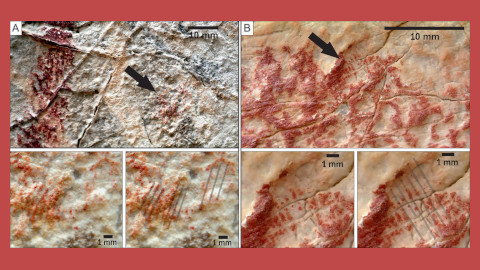Fingerprint study identifies authorship of rupestrian art

A research group co-led by the UAB for the first time has applied the study of palaeodermatoglyphics to rupestrian art. They did so at the Los Machos rockshelter in Granada, where two fingerprints were identified belonging to two individuals of different ages and probably gender. The study demonstrates the potential of this technique to delve deeper into the socio-cultural context of prehistoric art.
Rupestrian paintings may be one of humanity's most widespread symbolic manifestations. Research in this field focuses on the study of the motifs represented, their meaning, geographical distribution and chronology. But who painted or etched the engravings is one of the questions which most intrigue researchers: discovering the gender and age of the authors of these pictoric panels would allow defining the social context in which they were made, and whether they were individual actions or done by several members of the community.
In a study published in the journal Antiquity researchers explain how for the first time they used the study of palaeodermatoglyphics, or the study of ancient fingerprints, with rupestrian art and demonstrate the potential of htis technique in the study of prehistoric art. The analyses were conducted by the UAB's GROB (Osteobiography Research Group) - with Professor Assumpció Malgosa as coordinator - and they served to discern the biological profile of the authors of the schematic art anel in the rockshelter of Los Machos, located on the eastern slope of the Cerro de Jabalcón in Zújar, Granada, and dating back some 7,000 to 5,000 years ago.
Researchers identified 32 painted motifs and identified the fingerprints of two different individuals: an adult male, older than 36, and possibly a young female or, even more probably, a juvenile individual who could be either girl or boy.
"The identification of two individuals of different ages and genders opens new perspectives in the interpretation of rupestrian art with regards to the social context in which they were made, pointing to the participation of different members of the community. It demonstrates that the representations were not limited to a specific age or gender group", Assumpció Malgosa states.
According to researchers, the paintings identified most probably have been fully preserved, and the study also was able to determine, given the superposition of figures and the different colours of the pigments, that there were two phases to the paintings, corresponding to two different chronological episodes. The fingerprints found belonged to the second phase, the most recent one, which had been made using a dark ochre pigment.
The research also conduct an analysis of the rockshelter and the pictoric panel, which included its geological morphology (factor determining its state of presearvation and durability of the paint until today),the techniques used, the regional archaeological context, the chronological attribution and the identification of the biological profile of the authorships of these paintings through palaeodermatoglyphic analyses.
The following researchers have participated in the study: Francisco Martínez Sevilla (Universidad de Alcalá), Meritxell Arqués, Xavier Jordana and Assumpció Malgosa (Universitat Autònoma de Barcelona), José Antonio Lozano Rodríguez, Margarita Sánchez Romero and Javier Carrasco Rus (Universidad de Granada) and Kate Sharpe (Durham University, UK).
What palaeodermatoglyphs tell us
Palaeodermatoglyphs are fingerprints found within archaeological contexts. They are ancient skin prints made accidentally, or even voluntarily, and which can be found on different materials, such as cave walls and on the surface of ceramic pieces.
In cases that are well preserved, the study allows identifying the gender and age of their authors through the analysis of finger ridges: there are differences in the number of ridges and in width according to gender, because men have larger ridges than women. At the same time, there are also peculiarities according to age: despite not changing in a person's lifetime, fingerprints do experience a growth in the distance between ridges in childhood which then stabilise when reaching adulthood. The study of archaeological fingerprints and the comparison with current fingerprints allows defining the gender and age.
Original article: Martínez-Sevilla, F., Arqués, M., Jordana, X., Malgosa, A., Lozano Rodríguez, J.A., Sánchez Romero, M., Sharpe, K. y Carrasco Rus, J. (2020). Who painted that? The authorship of Schematic rock art at the Los Machos rockshelter in southern Iberia. Antiquity, 1-19. DOI: https://doi.org/10.15184/aqy.2020.140






